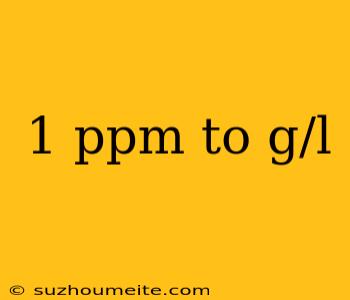1 ppm to g/l: Conversion and Explanation
In scientific and technical applications, concentrations of substances are often expressed in different units. Two common units of concentration are parts per million (ppm) and grams per liter (g/L). Understanding the conversion between these units is essential to accurately express and compare concentrations.
What is ppm?
Parts per million (ppm) is a unit of concentration that represents the number of units of a substance per million units of a solution or mixture. In other words, it is a ratio of the mass of a solute to the mass of the solution. For example, a concentration of 1 ppm means that there is one unit of a substance per million units of the solution.
What is g/L?
Grams per liter (g/L) is a unit of concentration that represents the mass of a substance per unit volume of a solution or mixture. It is often used to express the concentration of a substance in a liquid solution.
Conversion from ppm to g/L
To convert a concentration from ppm to g/L, we need to know the density of the solution. The density of a solution is typically expressed in units of grams per milliliter (g/mL). The conversion factor from ppm to g/L is as follows:
1 ppm = (density of the solution in g/mL) x (1/1000)
For example, if the density of the solution is 1 g/mL, then:
1 ppm = (1 g/mL) x (1/1000) = 0.001 g/L
Conversion Example
Suppose we want to convert a concentration of 5 ppm to g/L, and the density of the solution is 1.2 g/mL.
5 ppm = (1.2 g/mL) x (5/1000) = 0.006 g/L
Conclusion
In conclusion, converting concentrations from ppm to g/L requires knowledge of the density of the solution. Understanding the conversion factor and performing the conversion accurately is crucial in various scientific and technical applications.
